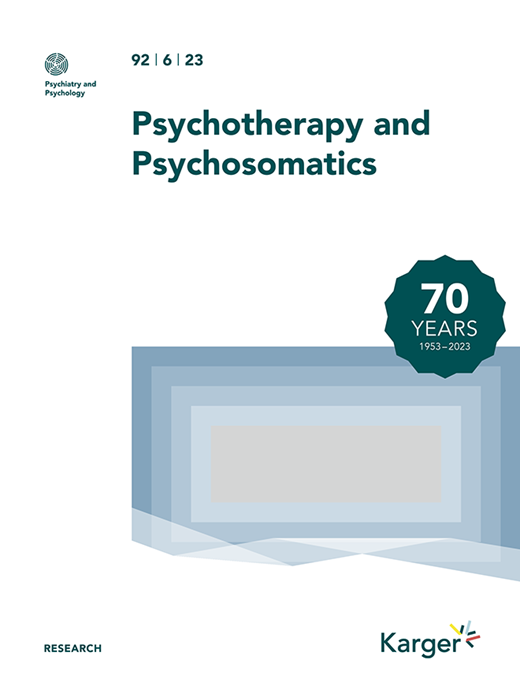Beyond Self-Reports: Integrating Cortisol Measurement in Psychotherapy Process Research among Adolescents with Borderline Personality Pathology.
IF 17.4
1区 医学
Q1 PSYCHIATRY
引用次数: 0
Abstract
Psychotherapy is the primary treatment for adolescent Borderline Personality Pathology (BPP), yet its mechanisms remain unclear. Given potential self-report biases due to alexithymia and impaired interoception, this study examined cortisol responses as a physiological stress marker alongside session ratings from adolescent BPP patients and their therapists to assess its potential as a complementary measure in psychotherapy process research. N = 56 adolescents (94.6% female) with BPP (≥ 3 DSM-IV BPD criteria) receiving Adolescent Identity Treatment or Dialectical Behavioral Therapy and their therapists provided pre- and post-session salivary cortisol samples and completed the Session Evaluation Questionnaire. Residual Dynamic Structural Equation Modelling examined associations between cortisol responses and session ratings, with moderation by age, depression, BPP severity, identity diffusion, and trauma. Cortisol responses did not correlate with session ratings in patients. In therapists, higher cortisol responses were associated with lower session smoothness (r = -.164; p < .001) and deepness (r = -.086; p = .004), as well as with lower positivity (r = -.145; p < .001) and higher arousal (r = .072; p = .012) post-session. Higher depression levels moderated the association between cortisol responses and session deepness in patients (β = -.009, p = .007). While session ratings and cortisol responses correlated in therapists, no such correlation was found in patients. Possible mechanisms include altered interoceptive abilities, dysregulated hypothalamic-pituitary-adrenal (HPA) axis function, or increased variability in self-ratings or cortisol due to BPP. While physiological markers and self-reports offer complementary insights into psychotherapy processes, future studies should include healthy and clinical controls and baseline investigation of HPA axis function (i.e. stress reactivity) in both groups, along with additional hormonal markers.超越自我报告:在边缘型人格病理学青少年心理治疗过程研究中整合皮质醇测量。
心理治疗是青少年边缘性人格病理学(BPP)的主要治疗方法,但其机制尚不清楚。鉴于述情障碍和内感受受损可能导致的自我报告偏差,本研究将皮质醇反应与青少年BPP患者及其治疗师的会话评分一起作为生理应激标记,以评估其作为心理治疗过程研究补充措施的潜力。N = 56名接受青少年认同治疗或辩证行为治疗的BPP(≥3项DSM-IV BPD标准)青少年(94.6%为女性),治疗师提供治疗前和治疗后唾液皮质醇样本,并填写治疗评估问卷。剩余动态结构方程模型检验了皮质醇反应与会话评分之间的关系,并通过年龄、抑郁、BPP严重程度、身份扩散和创伤来调节。皮质醇反应与患者的疗程评分无关。在治疗师中,较高的皮质醇反应与较低的会话平滑度(r = - 0.164; p < 0.001)和深度(r = - 0.086; p = 0.004)以及较低的积极性(r = - 0.145; p < 0.001)和较高的唤醒(r = 0.072; p = 0.012)相关。较高的抑郁水平调节了患者皮质醇反应和会话深度之间的关联(β = - 0.009, p = 0.007)。虽然疗程评分和皮质醇反应在治疗师中有相关性,但在患者中没有发现这种相关性。可能的机制包括内感受能力改变,下丘脑-垂体-肾上腺(HPA)轴功能失调,或由于BPP导致的自我评分或皮质醇变异性增加。虽然生理标记和自我报告为心理治疗过程提供了补充见解,但未来的研究应包括健康和临床对照以及两组中HPA轴功能(即应激反应)的基线调查,以及其他激素标记。
本文章由计算机程序翻译,如有差异,请以英文原文为准。
求助全文
约1分钟内获得全文
求助全文
来源期刊

Psychotherapy and Psychosomatics
医学-精神病学
CiteScore
29.40
自引率
6.10%
发文量
46
期刊介绍:
Psychotherapy and Psychosomatics is a reputable journal that has been published since 1953. Over the years, it has gained recognition for its independence, originality, and methodological rigor. The journal has been at the forefront of research in psychosomatic medicine, psychotherapy research, and psychopharmacology, and has contributed to the development of new lines of research in these areas. It is now ranked among the world's most cited journals in the field.
As the official journal of the International College of Psychosomatic Medicine and the World Federation for Psychotherapy, Psychotherapy and Psychosomatics serves as a platform for discussing current and controversial issues and showcasing innovations in assessment and treatment. It offers a unique forum for cutting-edge thinking at the intersection of medical and behavioral sciences, catering to both practicing clinicians and researchers.
The journal is indexed in various databases and platforms such as PubMed, MEDLINE, Web of Science, Science Citation Index, Social Sciences Citation Index, Science Citation Index Expanded, BIOSIS Previews, Google Scholar, Academic Search, and Health Research Premium Collection, among others.
 求助内容:
求助内容: 应助结果提醒方式:
应助结果提醒方式:


